When it comes to travel, plenty of people think about bringing their dog along. But what about including the family cat? Felines enjoy a change in scenery, too. It beats remaining cooped up at home with a pet-sitter. (Or worse, staying in a kennel) You need to make sure you’re providing the same safe travel conditions, of course, but that’s not difficult. With cat carriers, kitties can ride along in cars – or planes – in comfort AND safety. But not all cat carriers are created equal. Let’s make sure you’re picking out the right one for your trip.
Car Safety
Whether using dog car seats or cat carriers, the most common practice is to seat belt your pet in place and think everything’s fine. After all, the packaging SAYS the carrier is safe for use in a vehicle. However, in an accident, the reality is most carriers WON’T provide the protection owners think.
Hard-sided carriers tend to shatter on impact. The plastic and metal pieces turn into projectiles (which pose a hazard to YOU, as well). Seatbelts run the risk of snapping, releasing soft-sided carriers from their position on the seat. The only safe cat carriers? Those with a Center for Pet Safety (CPS) certification.
Unfortunately, CPS carriers tip the scales on cost. All of them, regardless of manufacturer, come in over $100. Which translates to few reviews. As such, you won’t see them on this list. But if you want the SAFEST cat carrier for car travel? Those are the options to consider.
Maximizing Cat Carrier Safety in the Car
What about the cat carriers on this list, then? Does that mean they’re off-limits for car use? Not necessarily. (Even the CPS understands that cat owners have budgets)
Lindsey A. Wolko founded the CPS. And her recommendation? Cat carriers should go on the floor BEHIND the front seat. It’s the safest place for your cat to travel. The footwell restricts the carrier from flying around the car in the case of an accident. And the seat shields them from potential debris.
You CAN use a seatbelt, but your cat should ALWAYS go in the back seat – NEVER the front. Remember, you want to keep them safe.
Types of Cat Carriers
In the beginning, cat carriers didn’t offer much variety. But people also didn’t think about traveling with their felines. Now, people include their cats on adventures. You see kitties all over social media, hiking and exploring in their harnesses. And with cat-lovers putting pressure on the pet industry, cat carriers have bloomed.
- Cardboard Carriers: Typically, you only see cardboard when you adopt a new cat. And these carriers AREN’T designed for regular use. They fall apart FAST.
- Hard-Sided Carriers: Made of durable plastic, hard-sided carriers work well for occasional use. They’re the easiest to clean, and they provide the most room. But they take up a lot of storage space, and they’re not the most comfortable for your kitty.
- Rolling Carriers: If lifting is difficult for you, rolling cat carriers are a nice alternative. They’re roomy and comfortable. However, they’re not airline-approved and don’t work well in cars. Also, the sound of the wheels is LOUD for your cat. And if you’re not gentle, your cat is going to feel like they’re on the Tilt-a-Whirl.
- Soft-Sided Carriers: Soft-sided cat carriers come in comfortable materials (nylon or polyester, usually), and they’re lightweight. They’re cleared by most airlines due to their flexibility, and they work the best for long car trips. Some even expand to give your cat extra room. But unhappy felines can claw or chew through the mesh. And they’re not easy to clean.
- Strollers: Obviously, you’re not getting a stroller on a plane, and it’s tricky to secure into a car. Some cats enjoy them, but others feel vulnerable. And the same concerns with the wheels apply as with the rolling cat carriers.
Choosing a Cat Carrier
You know your cat best. You also know what your plans are for the cat carrier. Are you going to be hitting the skies? Or do you have family road trips planned? Maybe you only need a cat carrier to go to the vet once or twice a year. How you use the cat carrier will help you decide on the type you need. And then you can zero in on these important features.
- Size: Your cat needs room to stand, sit, turn around, and lie down. But you don’t want them rattling around in the cat carrier – that can cause injuries. And if you’re flying? You want to meet the airline’s requirements.
- Doors: When it comes to cats, two doors are better than one. Even the largest cats manage to flatten themselves to the back of the carrier when nervous. A second door will help you out, so you’re not dragging them (or playing “Go Fish” through the front).
- Comfort: The cat carrier should come with a soft cushion on the bottom. Washable helps, too, in case of accidents.
- Carrying Methods: Ideally, you want a shoulder strap AND carrying handles. This keeps you comfortable and allows you to switch carrying modes. Padding doesn’t hurt, either.
- Ventilation: All cat carriers MUST have openings to allow for ventilation. But if there are TOO many, your cat may end up frightened by sounds or sights around them.
- Tether: Frightened cats MAY bolt out the door. You need a tether inside to connect to their harness. But ONLY do so when stopping – not during travel.
- Pockets: Maybe pockets aren’t critical for cat carriers, but they’re nice to have. You can store a leash, treats, or a cat toy.
- ID Tag: Of course, your cat has an ID tag on their collar or harness. But the carrier should have room for an ID card, as well – just in case.
Desensitizing Your Cat to a Cat Carrier
You CAN look for a cat carrier that’s easy to store. However, if you only drag the carrier out when it’s time for a trip (and that trip’s to the vet), your cat will develop a negative reaction. It’s much better if you keep cat carriers out in the open, where your cat doesn’t learn to fear them.
If your feline has never experienced traveling in a carrier before, you can slowly desensitize them to one.
- Place the cat carrier in a room your cat spends time in.
- Leave the doors open (remove them, if needed).
- Place treats inside, and play with your cat’s toys nearby.
- As your cat adjusts, start closing the door when they’re inside. Start with a few SECONDS. (Reward with praise and treats)
- Work your way up to minutes, continuing the rewards.
- On the first trip, tuck a shirt into the cat carrier, so your cat has your scent.
You’ll find your cat spending time in the carrier on their own. And they’ll enjoy the trips – because the carrier WON’T be frightening for them.
The Best Cat Carriers
People are getting away from the mold of “cats stay home.” More and more, they’re bringing felines out into the world with them. And cats love getting to see new sights. When you take the time to let them explore and adjust to a cat carrier, they start learning to love it. And car trips? They follow close behind. Before you know it, your kitty climbs into the carrier when they see you packing your bags! You’ll wonder how you ever planned a vacation without them.
The Best Expandable Cat Carriers
On especially long car trips, when you’ve reached your hotel or other destination, you want to offer your cat the most comfort possible. That’s where expandable cat carriers come in. These soft-sided options have extra zippered compartments that allow for additional space. It’s a nice option for larger cats that may feel cramped in smaller cat carriers. And when you’re camping or traveling with an RV? Your cat gets their personal “condo” situation!
Petsfit looks like an ordinary cat carrier initially until you unzip the two sides, revealing extra space that was tucked away. The polyester material features a water-resistant coating, and all of the zippers come with self-locking mechanisms to keep crafty felines from negotiating an escape. It comes in three sizes, accommodating even Maine Coons without a problem. And most airlines accept it (in the non-expanded form, of course). You get two handy entrances for loading and unloading, and there’s a safety tether inside. Plus, you get a washable plush cushion.
Downsides? There is A LOT of mesh on this cat carrier. It claims to be scratch-proof, but determined cats have no problem getting through it. And the cushion’s only on the main floor – it doesn’t extend into the wings.
The Good
- Expands on 2 sides
- Self-locking zippers and safety tether
- 2 Entrances
- Available in 3 sizes
- Accepted by most airlines
The Bad
- Too much mesh
- Cushion on main floor only
If you’re going to go for an expandable cat carrier, why not go all the way? That’s Slivton’s idea, anyway. This soft-sided carrier expands in FOUR directions! And the plush cushion folds out into two of the compartments, keeping your kitty nice and comfy. YOU can carry the Oxford and EVA board carrier four different ways, with the handles padded. It’s approved for most airlines (always double-check), and you get those crucial double doors.
The downsides? Again, you’re going to get a lot of mesh. And upset cats can go through it in no time. Also, it only comes in one size. While expandable, it may not work for all cat sizes when you need to close things up.
The Good
- Expands on 4 sides
- Safety tether
- 4 Ways to carry
- 2 Entrances
- Accepted by most airlines
The Bad
- Too much mesh
- Only available in 1 size
The Best Hard-Sided Cat Carriers
When you want the most durable, long-lasting cat carriers, you look for hard-sided. The plastic shells last through years and years of use. No matter how large your cat may be – or how determined – they’re not going to claw or chew through the sides. And the “mesh?” It’s wire. This makes them pretty indestructible (for cats, anyway – dogs are a different story). And if you need to clean them, a spray with the hose and a few hours out in the sun does the trick.
But they DON’T come with comfy mats in the bottom; you need to provide blankets or cushions. And they take up a lot of room in closets, garages, or your cat’s favorite room. They’re also NOT the safest cat carriers in a car accident. Especially because they DON’T come with safety tethers. So you have to balance things out and decide what’s the most important. If you’re only going to the vet now and then? These work fantastic. On long trips? Not so much.
Aspen represents the typical hard-sided cat carrier. You get a sturdy plastic shell with heavy-duty clips and a wire door. Your cat still gets plenty of ventilation without overdoing it. And you get two little “pockets” in the top for extra storage. The spring-loaded handle will foil even clever cats, but it’s easy for most people to manage. And it comes in eight different sizes (not all of those are suitable for cats) and six colors.
Downsides? You only have one door. True, you CAN remove the lid, but it requires unsnapping the sides AND unscrewing the front. It’s not impossible, just lengthy. And the handle isn’t padded, which means a little strain on your wrist (there’s no shoulder attachment).
The Good
- Heavy-duty plastic and wire
- 2 pockets for storage
- Spring-loaded door
- Available in 8 sizes
- Available in 6 colors
The Bad
- Only 1 door
- Only 1 handle
- Handle isn't padded
- Only approved for airline cargo
Pet Magasin offers a different twist on hard-sided cat carriers with their Collapsible Cat Carrier. The top and bottom feature rigid plastic, and the sides are reinforced for strength. But with a few quick zips, the entire carrier folds FLAT. This gives you two entrances, AND it makes it easy to store this particular carrier. It also includes a padded mat for the bottom – something unusual to find in hard-sided cat carriers.
The downsides? Due to the design, you miss out on that crucial safety tether. And no airlines approve this particular design; it sits too high. You’re also limited to a single size, which may not work for every feline. And while the handle isn’t rigid plastic, it’s also not padded – and without a shoulder strap option, that may get uncomfortable to carry.
The Good
- Rigid plastic and breathable mesh
- 2 Entrances
- Folds flat for storage
- Includes padded mat
The Bad
- Only 1 handle
- Handle isn't padded
- Not approved for airline travel
Petmate solves the struggle of attempting to coax your cat out of the back of their hard-sided cat carrier. You don’t have to struggle with unscrewing the sides, either. Simply engage the spring-loaded catch, and the top pops open. That’s two handy entrances, neither of which is difficult to manipulate. You’re still getting a durable plastic shell with wire mesh your cat won’t destroy. And you can’t beat the ventilation (though you do sacrifice the pockets). It comes in two handy sizes and four colors.
So what are the downsides? If you want to bring this cat carrier with you on the plane, it MUST go into the cargo unit. It’s also on the heavy side – which is troubling since there’s no shoulder strap, and the handle isn’t padded. And if you don’t get the top latched properly? Your cat WILL hop out in seconds (I’ve seen it happen).
The Good
- Heavy-duty plastic and wire
- 2 spring-loaded doors
- Available in 2 sizes
- Available in 4 colors
The Bad
- Heavy
- Only 1 handle
- Handle isn't padded
- Only approved for airline cargo
If you want a hard-sided cat carrier that offers comfort and stores away easily, you couldn’t go wrong with Sport Pet. With a few quick buckle releases, the triangular carrier folds down flat, making it easy to slide out of the way. When assembled, it allows your cat to travel in easy comfort. It comes complete with a plush bed in the bottom that’s easy to toss in the washing machine. And while there’s only one door, it’s wide enough that your cat will remain within easy reach. It also comes in two different sizes.
Downsides? This particular cat carrier is designed for easy use. As such, the components are made of plastic and prone to break. ALWAYS check everything thoroughly before you lift your cat, and keep one hand underneath. The locking mechanism has given out on people at times, allowing the door to pop open. Also, you’re getting an unpadded, plastic handle., which may irritate your grip. And this is NOT approved for airline travel – cargo or otherwise.
The Good
- Heavy-duty plastic
- Wide single entrance
- Available in 2 sizes
The Bad
- Questions of durability
- Only 1 handle
- Handle isn't padded
- Not approved for airline travel
The Best Soft-Sided Cat Carriers
For the well-traveled feline, soft-sided cat carriers are the way to go. They’re often approved for travel in airline cabins, and they receive higher scores in CPS crash tests. They almost always come with a comfortable cushion for those long trips, and they allow your cat the best mesh for ventilation and a view of the passing scenery.
However, they’re also the easiest cat carriers to escape from. Clever claws catch in zippers and move them enough for cats to push their heads out. Not to mention the mesh won’t hold against determined teeth or claws. And when it’s time to clean up after a stressed cat? Things get tricky. The more you work with your cat to acclimate them to the cat carrier, the better off you’ll be.
When you want a soft-sided cat carrier on a budget, Amazon Basics delivers. Following the traditional design, they stretch mesh panels over a springy wireframe. You get carry handles OR a shoulder strap, all comfortably padded. And your cat gets a removable fleece pad you can toss into the wash if it’s needed. It opens on the side or the top, making loading and unloading a cinch. And you have three different sizes to choose from.
Downsides? The materials aren’t the strongest, and plenty of cats have torn through the mesh in attempts to escape. The zippers don’t lock, so it’s also easy for kitty heads to pop through. And sizing runs to the small side, so make sure you estimate larger than you think you need.
The Good
- Mesh over wireframe
- 2 Entrances
- Safety tether
- Available in 3 sizes
- Accepted by most airlines
The Bad
- Mesh easily torn
- No safety features on zippers
- Sizing runs small
If you have a genuinely nervous cat, Henkelion may be the cat carrier for you. You have FOUR zippered entrances to work with. This also allows you to fold the carrier flat if you need to tuck it out of the way. You still get sturdy mesh to provide healthy ventilation, with a wireframe for stability. And it comes with a fleece bed for comfort (which is easy to wash). There are two carry handles and a detachable shoulder strap. Either way, it’s easy to secure the cat carrier for travel. You have two sizes and six colors to choose from.
The downsides? Despite the size options, this cat carrier runs small for the larger breeds out there. And while Henkelion claims the zippers are self-locking, they’re standard zippers. This means your cat can orchestrate a jailbreak.
The Good
- Mesh over wireframe
- 4 Entrances
- Safety tether
- Available in 2 sizes
- Available in 6 colors
- Accepted by most airlines
The Bad
- Mesh easily torn
- No safety features on zippers
- Too small for larger cats
Neco Ichi adopts a unique design for their cat carrier. The lightweight nylon pops up from a flat circle into the nifty triangular shape, complete with mesh windows for ventilation. It’s easy to wipe down if you need a quick cleaning, and it won’t take up much room, no matter where you choose to store it. The zipper comes with a crucial locking ring to prevent clever felines from sneaking out. And it weighs almost nothing for YOU!
So what are the downsides? The weight limit on this cat carrier is 18 pounds (but 15 is more realistic). While a soft-sided cat carrier, the design DOESN’T work well for car travel, especially as there’s no way to secure it properly. And while nylon’s durable, I’ve watched no fewer than three cats claw their way through this carrier in veterinary hospitals. Also, there’s no shoulder strap, and it’s awkward to carry (personal experience).
The Good
- Nylon and mesh
- Locking ring on zipper
- Available in 2 colors
The Bad
- Cats must weigh less than 15 pounds
- Easily torn
- Only 1 handle
- No padding on handle
- Not approved for airline travel
When you want to maximize car safety, you turn to Pet Gear. You get the same nylon and mesh construction, with the bonus of a seatbelt connection. And, of course, there’s that additional safety tether inside. Your cat will stay comfortable and sturdy whether you’re going to the vet or on vacation. A fleece bed comes included, and the front unzips wide to allow you to reach inside.
Downsides? The zippers don’t lock, which means you need to keep an eye on your feline (which runs counter to good driving practices). Also, the mesh isn’t the sturdiest, and cats have torn through it without a problem. You get carry handles, but no shoulder strap, so make sure you’ve done your arm day at the gym.
The Good
- Nylon and mesh on wireframe
- Seatbelt connection
- Safety tether
The Bad
- Mesh easily torn
- No safety features on zippers
- Only 1 handle
- Not approved for airline travel
Yup, Pet Magasin makes a second appearance on this list. Their Luxury Soft-Sided Carrier uses nylon and mesh to keep your cat comfortable no matter where they’re headed. And since it only weighs 2.2 pounds and features padded carry handles and shoulder strap, you won’t mind carrying it around, either. Extra padding inside ensures your cat stays nice and comfortable, even if they embark on air travel. And when you’re finished? You can fold it flat and push it out of the way. It comes in four different vibrant colors, suitable for every feline’s personality.
The downsides? You only have one size to choose from. And since the base lacks a rigid form, heavier cats may SINK when carried. That’s not comfortable for anyone. Also, if you unzip TOO much, your cat’s going to bolt out, as that’s how you fold the cat carrier. It’s not an ideal construction, and it prevents a second entrance.
The Good
- Nylon and mesh
- Lightweight
- Folds flat
- Available in 4 colors
- Accepted by most airlines
The Bad
- Mesh easily torn
- No safety features on zippers
- Only available in 1 size
- Only 1 entrance
Interested in trying something different for your cat carrier? PetAmi has just the thing. The durable 600D polyester and mesh provide the perfect environment for your cat to join you on outdoor explorations. You can open the two sides or the front window (though it’s on the small side for large cats to fit through). A Velcro fleece pad secures into the bottom, and when you need to clean things off, everything can go into the washing machine. All of the zippers lock together, preventing even the smartest cats from escaping. And for you? The straps have extra padding, and you get a waist and chest clip to adjust things for the perfect fit.
These are the cat carriers we use, and we haven’t looked back. They fit perfectly in the footwell without tipping over (even with our cerebellar hypoplasia kiddo). The vet offices adore them. And when our youngest cat wants to join the dog on her walks? She hops in her backpack (they’re color-coded), and off we go.
So what are the downsides? Obviously, you’re not getting a backpack approved for airline travel. And if you’re on the shorter side, the backpack digs into your lower back. If you adjust all of the straps, though, this shouldn’t be a problem. You probably WON’T fit more than a 15-pound cat inside comfortably, though.
The Good
- 600D polyester and mesh
- 3 Entrances
- Locking zippers
- Safety tether
- Available in 12 colors
The Bad
- Cats must weigh less than 15 pounds
- Mesh easily torn
- Can dig into lower back if not adjusted properly
- Not approved for airline travel
If you need the most space for your cat, you want PetLuv. They allow for up to FORTY-FIVE POUNDS. (If your cat weighs more than that, you need to have a frank discussion with your vet about weight loss) You won’t get it on a plane, but it’s perfect for lengthy car trips and vacations. The nylon canvas and mesh stretch over sturdy wire. And each opening comes complete with a privacy shade to let your cat have time to themselves. You also get one of the fluffiest fleece beds out there, allowing your cat to relax in ultimate comfort. It comes in two sizes, and you have four colors to choose from.
Downsides? This much luxury comes with a price tag. It also gets tricky to secure in the car. Ensure you’re using ALL of the provided straps (it won’t fit in the footwell). You’ll also have to forgo a shoulder strap – it’s simply too large. You DO get a padded, adjustable carry handle, though.
The Good
- Nylon canvas and mesh
- 4 Entrances
- Safety tether
- Privacy screens
- Available in 2 sizes
- Available in 4 colors
The Bad
- Expensive
- Mesh easily torn
- Difficult to secure in car
- Only 1 handle
- Not approved for airline travel
When you think travel – especially air travel – and cat carriers, you think Sherpa. They pioneered pet carriers for airline cabins. And with their springy wireframes, this cat carrier will slide under the seat without a problem. The mesh is one of the sturdiest out there, with a nylon shell that receives double-stitching to endure frequent flights. The comfy fleece pad slides out when you need to clean it, and there’s an extra loop to slide over your luggage handle.
The downsides? That springy frame is designed to give – and it usually does so when you DON’T want the top collapsing. It’s one of the biggest reasons I stopped using these cat carriers. You DO get a shoulder strap, but it’s not padded, and on long trips, it starts digging in. And the zippers DON’T lock. I had one cat that worked her foot through in the ten-minute car ride to the vet.
The Good
- Nylon and mesh on wireframe
- 2 Entrances
- Safety tether
- Available in 3 sizes
- Available in 8 colors
- Accepted by most airlines
The Bad
- Mesh easily torn
- No safety features on zippers
- Top collapses easily
- Shoulder strap not padded
Road Trip!
Cats have often taken a “back seat” on our adventures (no pun intended). But with better cat carriers hitting the market, now they can join the rest of the family. As long as you observe car safety – and give your feline time to adjust to their new carrier – there’s no reason to exclude them from the fun.
You’ll probably find them eagerly joining in with the planning!

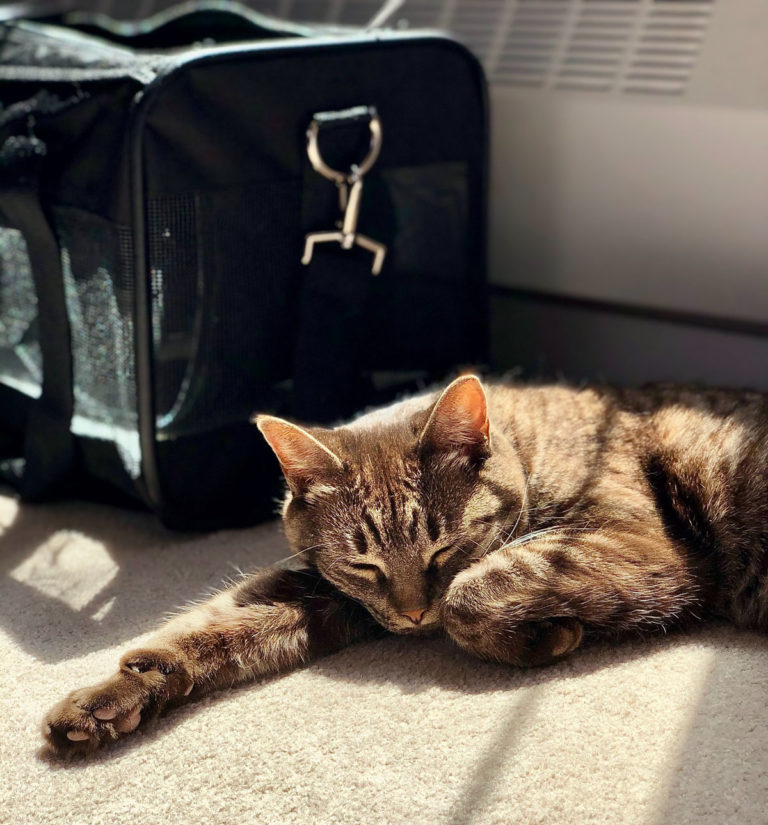
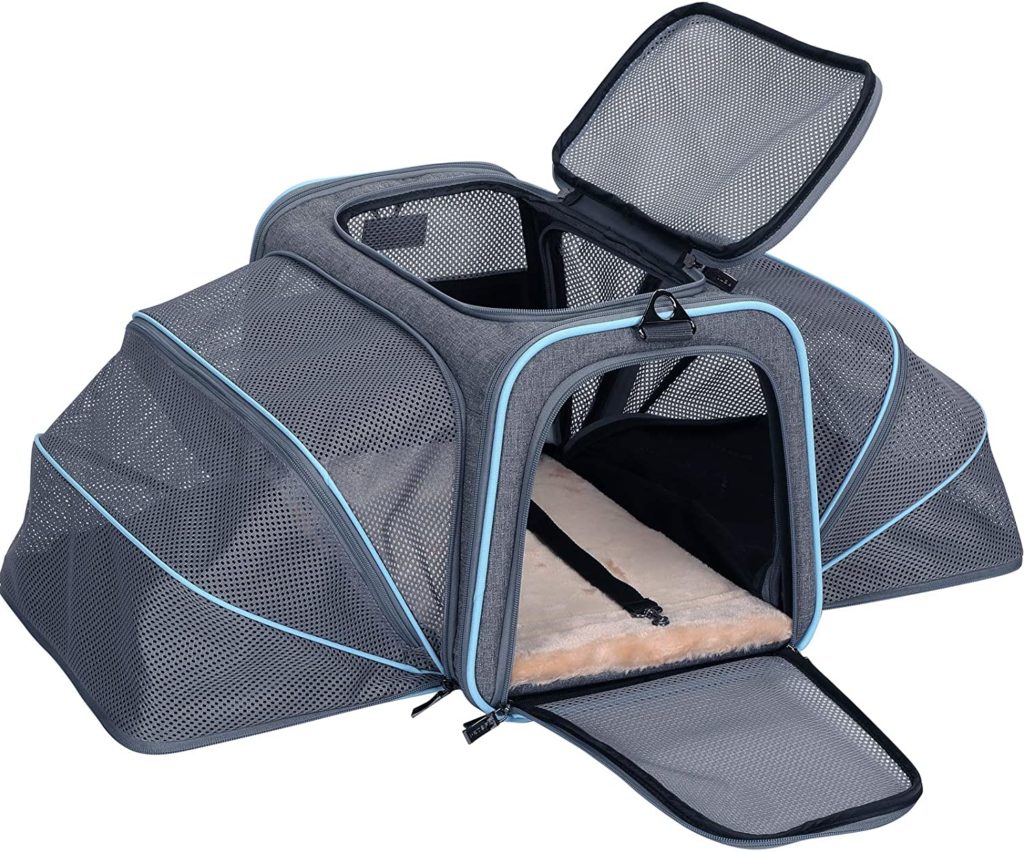
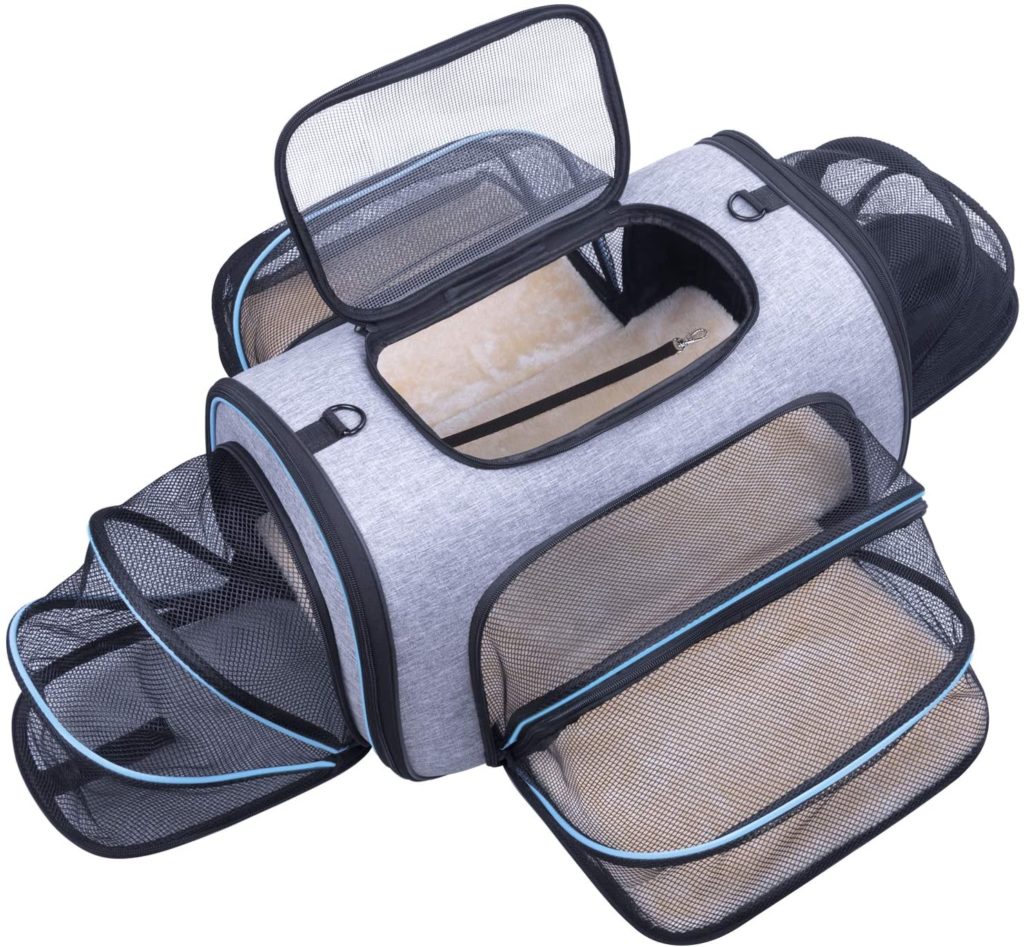
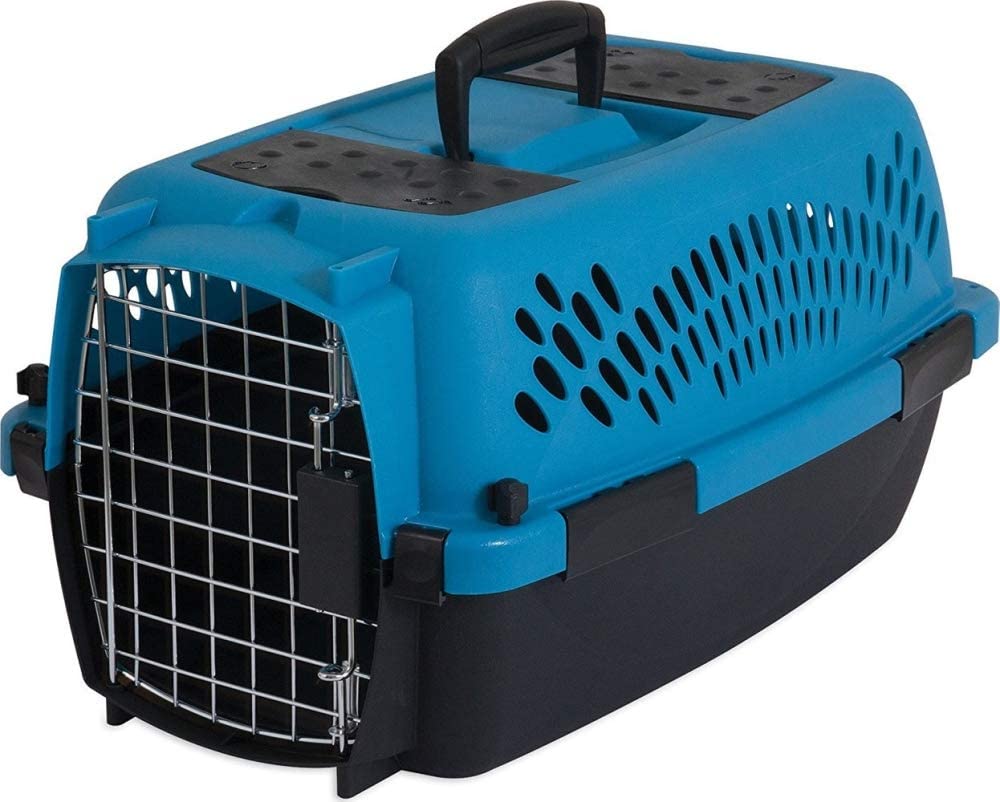
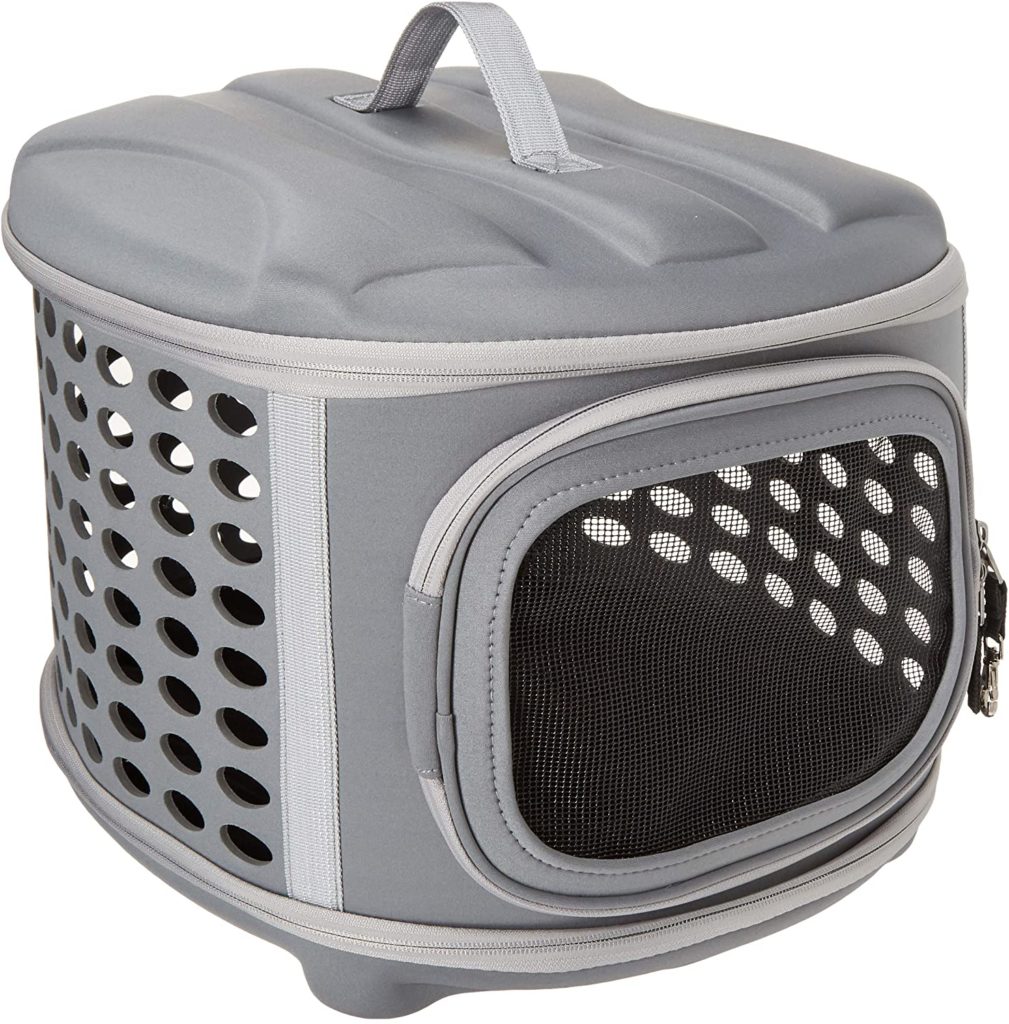
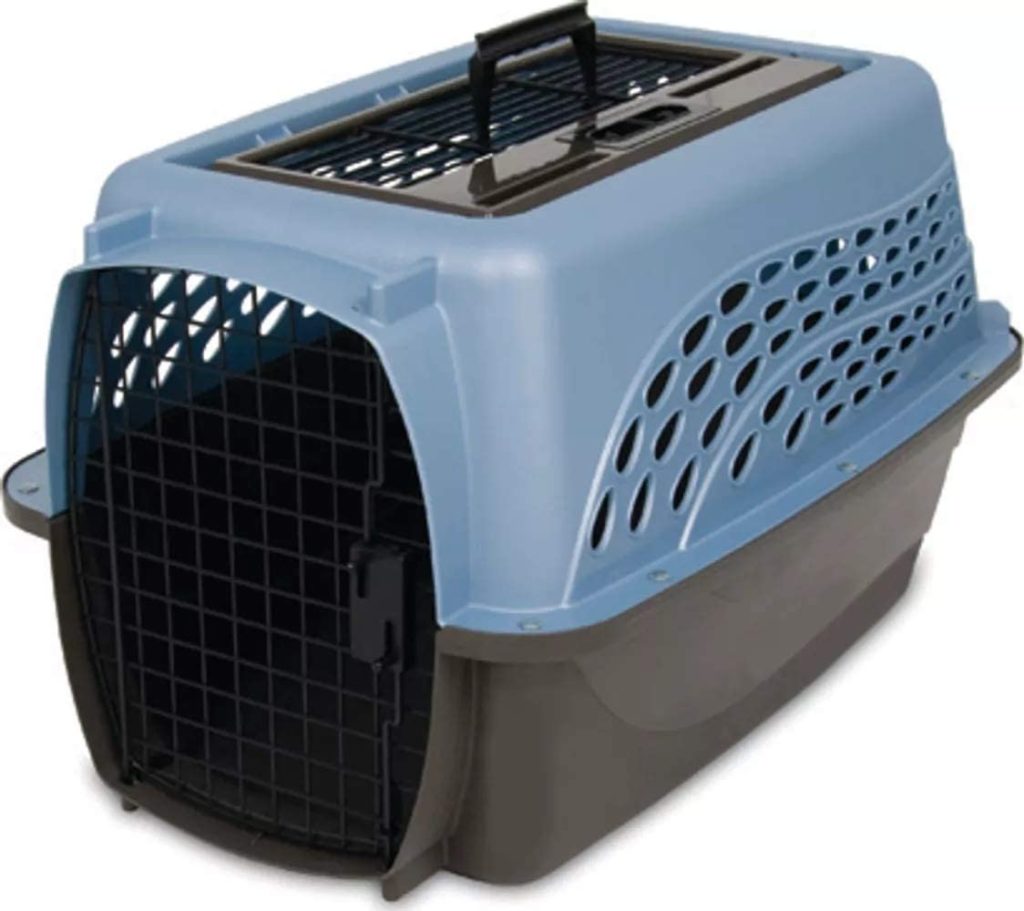
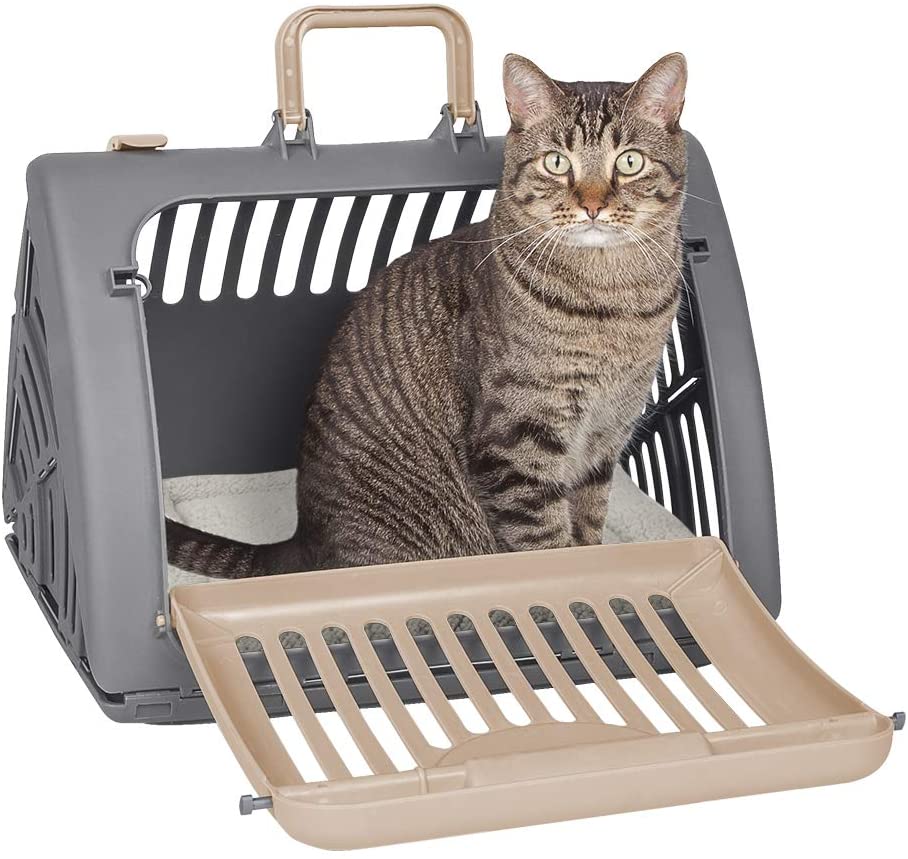
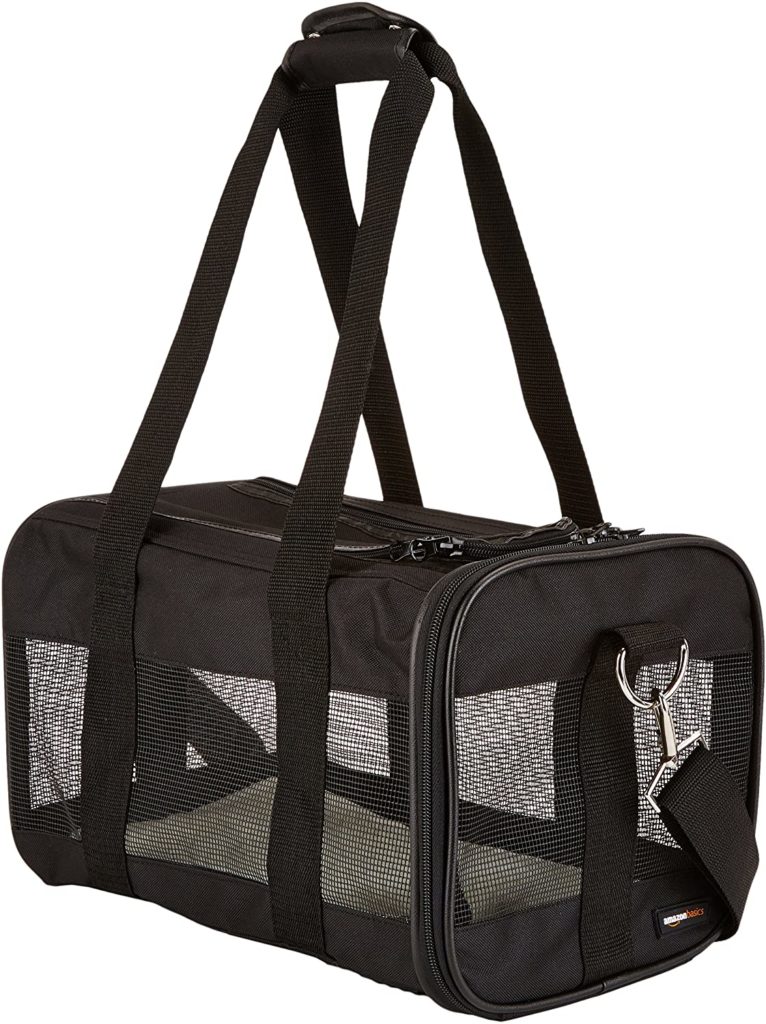
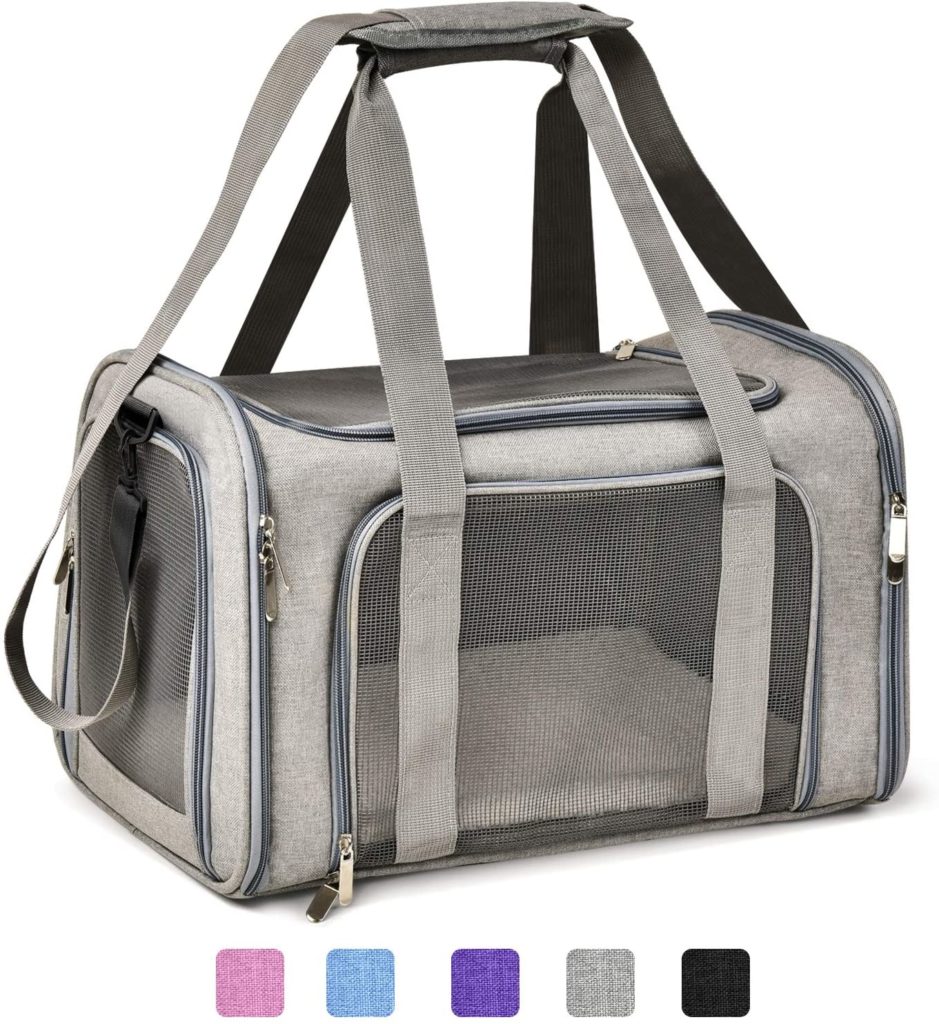
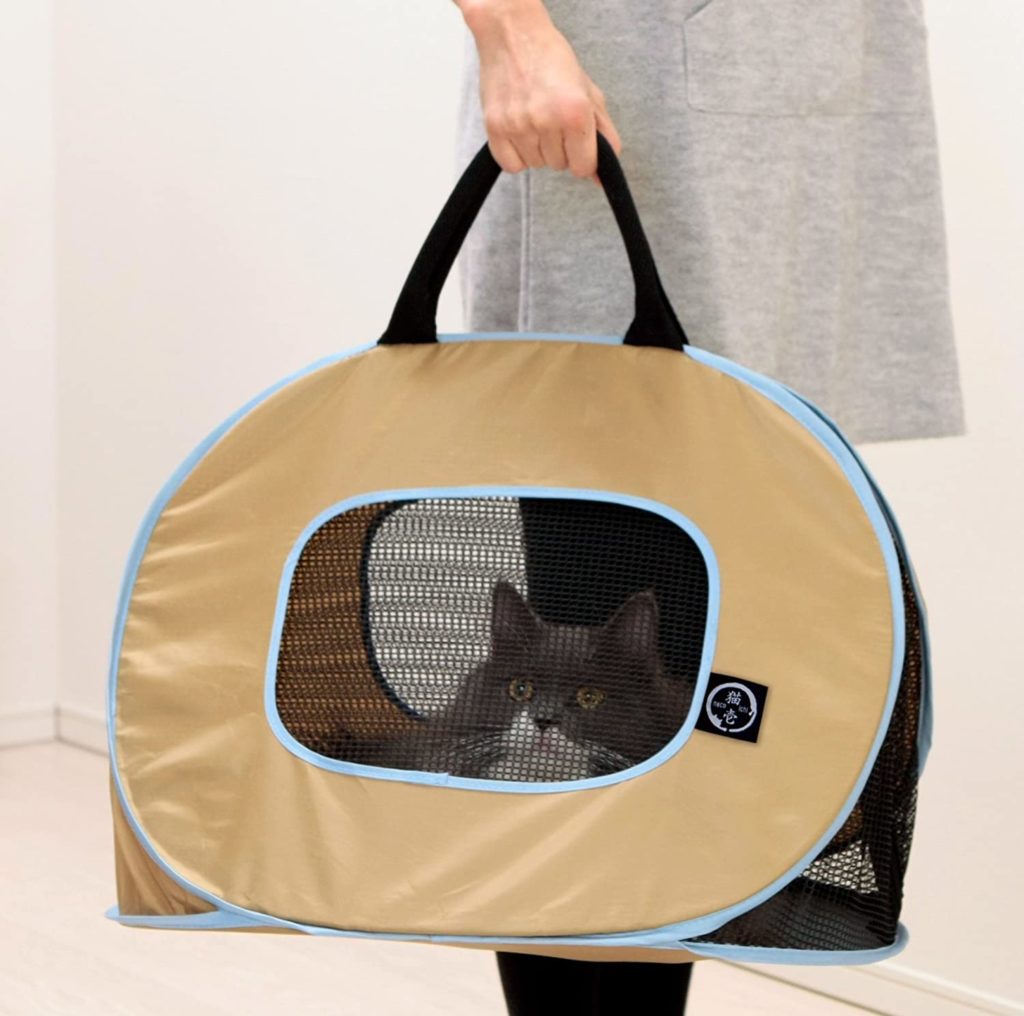
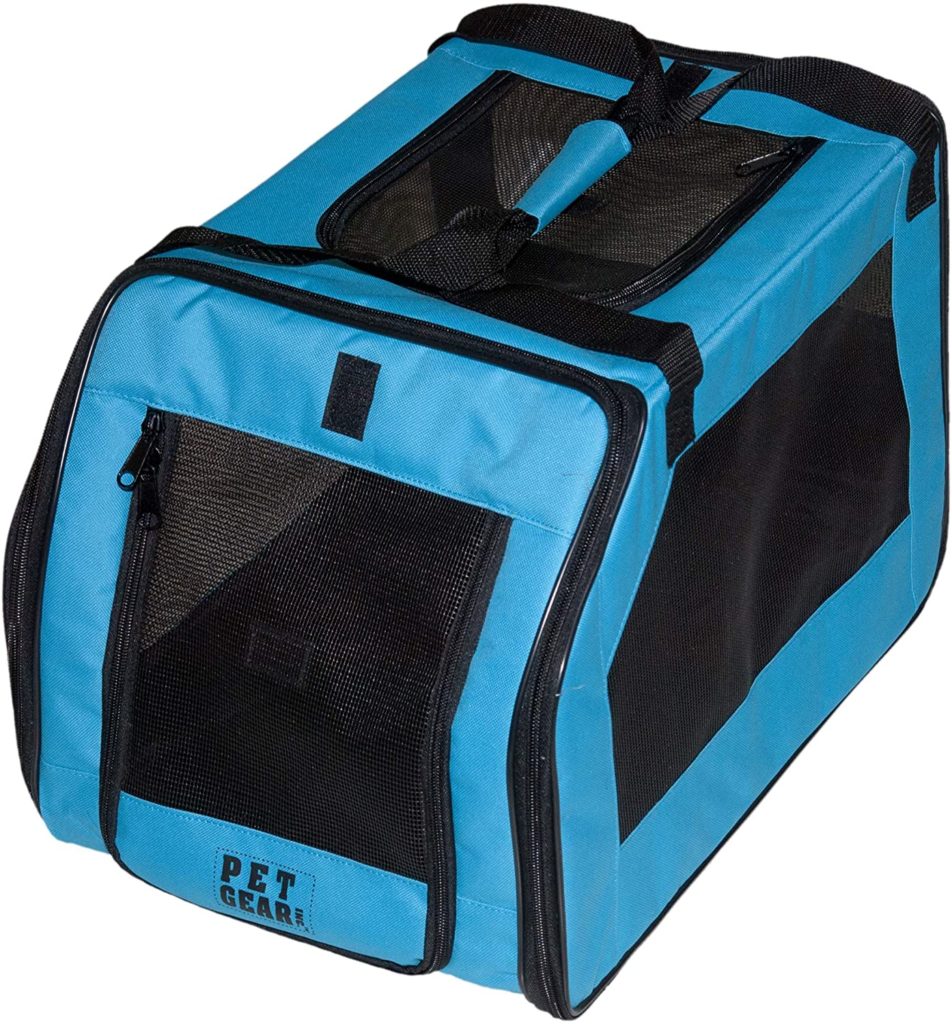
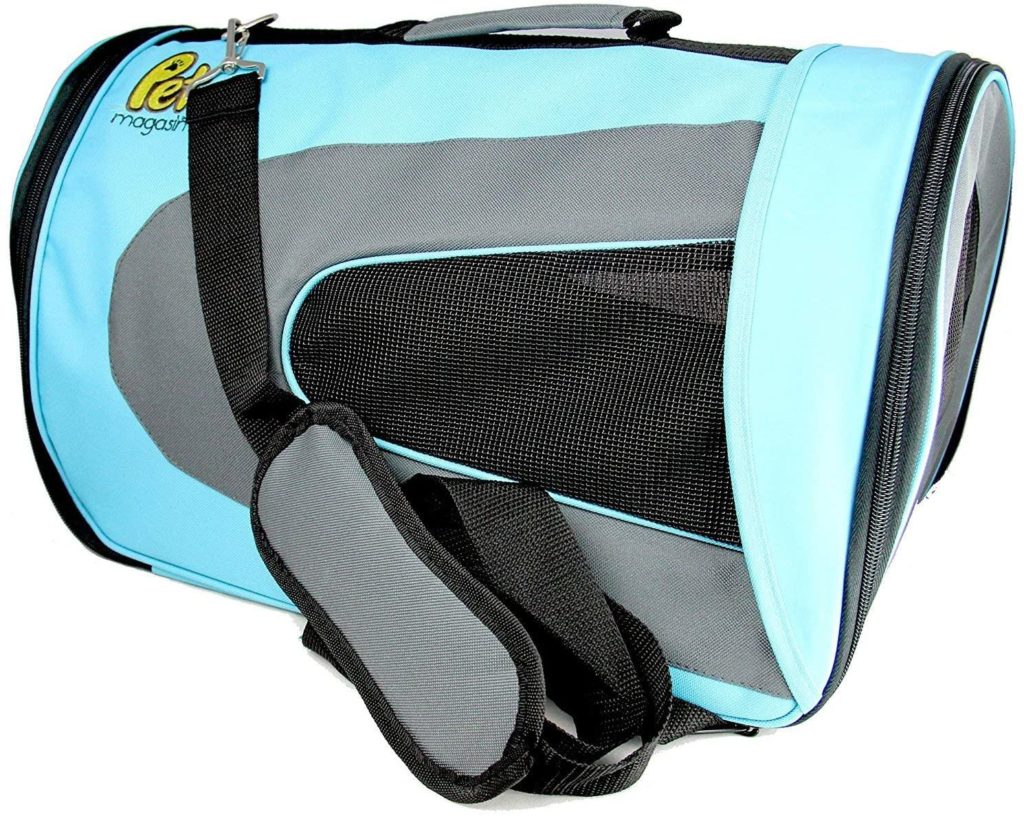
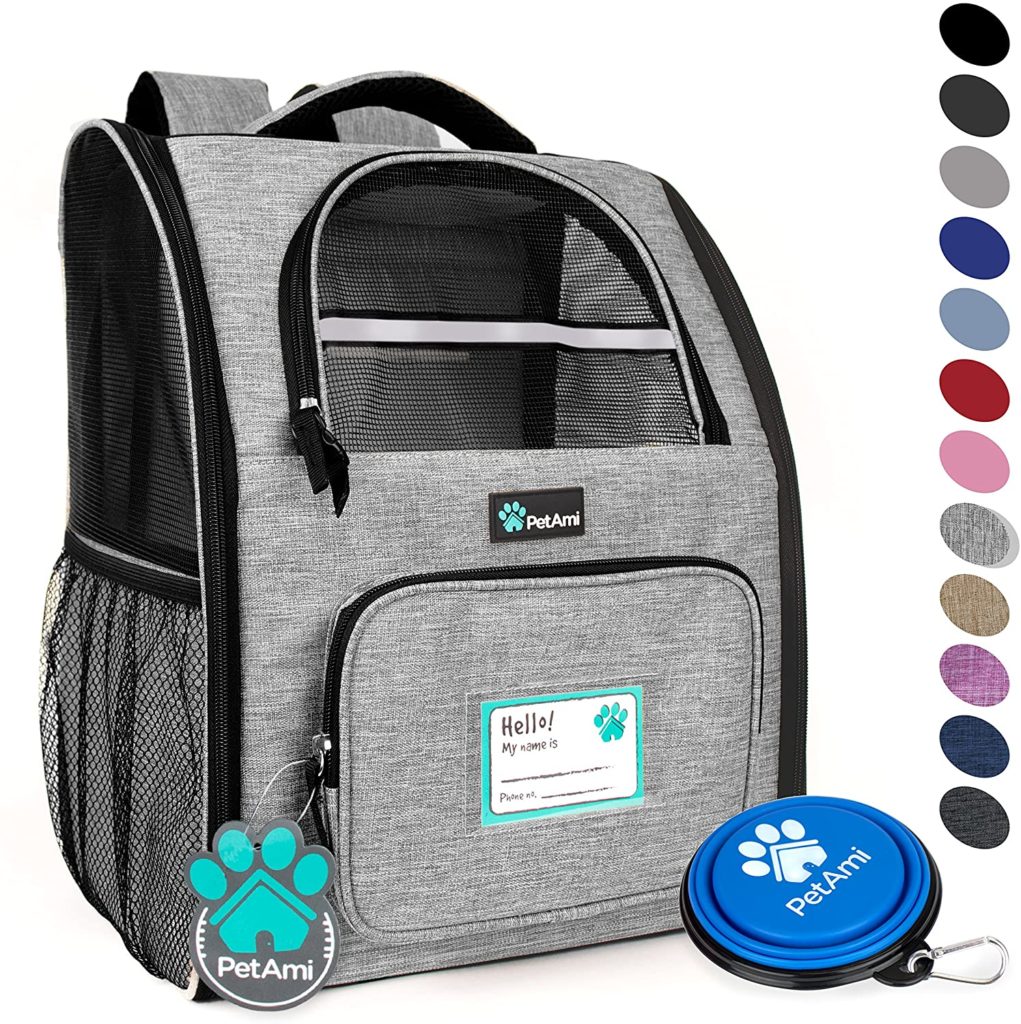
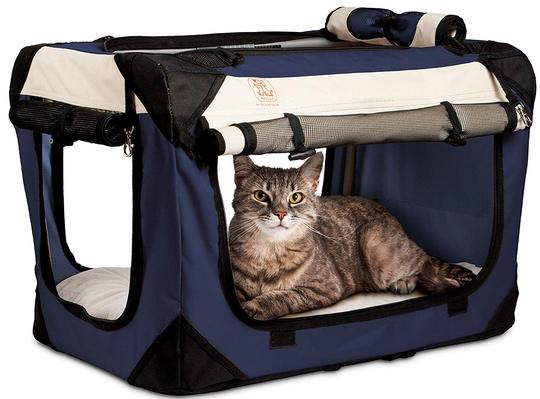
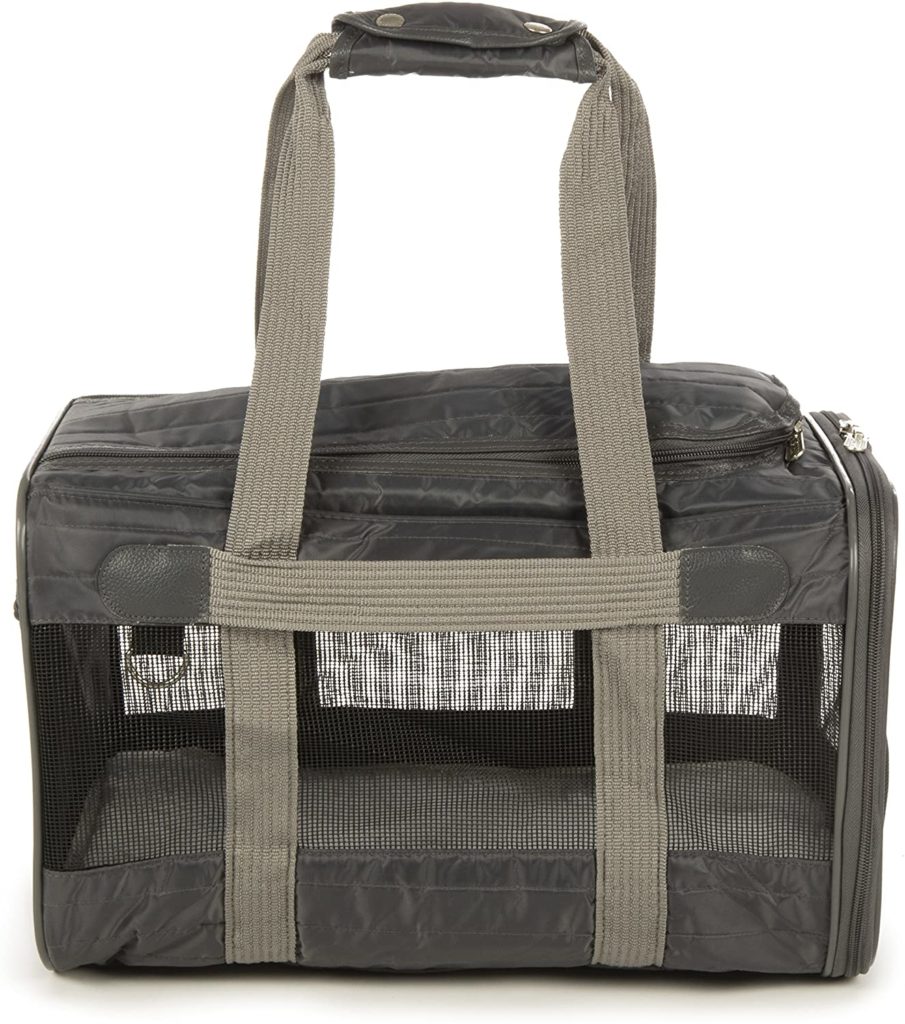




No comment yet, add your voice below!